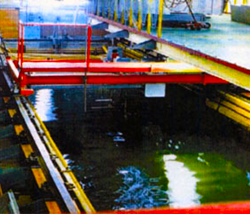Ocean Dynamics
NOAA is increasingly monitoring ocean circulation and dynamics by
means of remote sensors that probe its surface from ships,
aircraft, and satellites. To infer underlying dynamics from the
surface properties revealed by radars, radiometers, and lidars
requires fundamental advances in our understanding of the surface
manifestations of subsurface processes. One example is the way
internal waves and long surface waves (swell) modify the short
surface waves with which these sensors interact. Without such
understanding, the sensors could give incorrect information about
the motions of cold and warm currents, the transport of nutrients
and pollutants, and air-sea interactions that affect weather and
climate. We combine theoretical studies with laboratory modeling
and field experiments at sea to make headway on this extremely
complex problem.
Methods & Outcomes
Advanced models are needed to describe wave interactions. We are
developing such models using both analytical and numerical methods.
We have developed a theory of strong internal solitons that shows
better agreement with observations than the commonly used model
equations. A new numerical algorithm has been developed to simulate
this class of processes. For surface waves, we have made progress
in describing the modulation of short surface waves by long waves
in the presence of turbulent wind. In connection with laboratory
experiments, a theory of interactions between internal waves,
currents and turbulence has been constructed.
We collaborate with the Institute of Applied Physics of the Russian
Academy of Sciences in Nizhni Novgorod, Russia. This institute has
created a unique laboratory complex including two density
stratified wave tanks. The larger tank is 20x4x2 m in size, and has
a closed wind-wave channel. The larger tank is equipped to simulate
a number of processes in the ocean with a scaling of about 1:100 in
size and 1:10 in velocity. Unique experimental data have been
obtained using these laboratory facilities. Such data includes the
distribution of curvatures of surface gravity waves, the evolution
of short surface wave packets, redistribution of surface wave
amplitudes over an obstacle, and damping of internal and surface
waves by turbulence.
|

A density stratified wave tank at the Institute of Applied Physics of the Russian Academy of Sciences, Nizhni Novgorod, Russia |
|
|
|